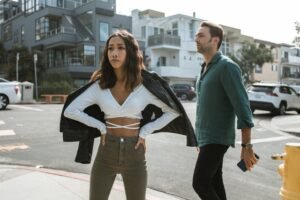What Do Fashion Designers Do?
Clothing and accessory collections are conceptualized and created by fashion designers on a season-to-season basis with a target market (the person who will wear the product) in mind.
Those working as fashion designers can be found in a variety of settings, including apparel or accessory manufacturers, couture houses or design studios, department and specialty stores, boutiques, and other retailers;
universities, where they can be found as an educator, a professor, a fashion historian, a dean, an administrator, or a researcher; and museums, where they can be found as curators.
Styles in fashion are affected by cultural standards and, in most cases, governed by the constantly shifting trends in society today. While some fashion designers opt to create with their own vision as their mechanism of creation, others choose to follow trends just to a limited extent or not at all, while others follow trends on a seasonal basis.

While it is often believed that fashion designers are primarily responsible for conceptualizing and sketching designs for clothing, in reality, they are engaged in a wide range of parts of the design process from beginning to end.
On the product development side, the garment designer collaborates closely with a group of employees who are critical in the process of developing a collection.
They are made up of patternmakers, who create full-size paper patterns for the manufacture of clothing, using their expertise in body proportions and fabric knowledge to translate the designer’s apparel sketches into various pattern pieces, and tailors and sewers, who construct and make prototypes and samples for the designer.
We provide a more in-depth examination of the duties and obligations of a clothing designer.
Many garment manufacturers, particularly the bigger and more known companies, provide a variety of products in more than one category. Within each product category, there are broad subcategories, which are further subdivided into consecutive sub-categories, and so on.
The size and structure of the organization determine whether you are responsible for designing one or more product categories, one or more subcategories, or one or more of the sub-subcategories in your role as a fashion designer. The following is an illustration of how subcategories within a broader product category are broken down:
- Men’s clothing (Product Category)
- Clothing that has been tailored (Subcategory)
- Suits
- Coats and blazers for sports activities
- Shirts for Formal Events
- Trousers
- Overcoats
- Tuxedos are formal attire (Sub-subcategory)
- Cummerbunds
- Bow ties are a popular fashion accessory.
There are six major categories of designers: 1) clothes designers, 2) accessories designers, 3) footwear designers, 4) technical designers, 5) CAD (computer-aided design) designers, and 6) textile designers. We’ll now take a deeper look at what each of these things does.
Apparel designer
In the field of garment design, a fashion designer makes clothes for women and men of all ages. He or she may specialize in one of the aforementioned function categories. He or she may also design for juniors and children. He or she may also design for layette.
An Interview with Ralph Rucci, Fashion Designer
for Chado Ralph Rucci
Was there a turning point in your youth, upbringing, or existence that inspired you to seek a profession in fashion design?
❯
I’ve always been enthralled by women’s beauty and the inner elegance they exude. I used to go shopping with my mother all the time as a kid, and I was frequently allowed to pick out her clothes from a young age.
She had a neighborhood seamstress, a guy of tremendous aptitude and experience, and I was permitted to pick Christian Dior and Balmain Vogue/Butterick patterns. Immediately, some images come to life.
A pillbox hat with a bright pink slipper satin Dior boxy bodice and straight pegged skirt. Small dangling crystals called briolettes were used to embellish the cap and the bodice.
I thought it was the most stylish thing I’d ever seen. My mother also had an emerald-green satin Dior coat that was effectively a half-circle with two very short sleeves and a wideband collar that reached past the décolleté, as I recall.
The flares swooned out in a grand, royal dance as she moved in this garment.
She wore an ivory duchess silk satin Balmain gown that was cut on the bias, with a sleeveless tight sheath swept to one side and hung to the high waist/low hip, and a large geisha obi as part of the ensemble.
The obi was doubled so that the cloth stayed crisp and stood out enough to be seen from the front.
The fact that this cocktail dress matched the social mood of the period added to its poignancy. My mother had it created for the premiere of a film she was going to see. Consider the following scenario: The premieres of films were attended by both men and women dressed in evening wear.
It was Elizabeth Taylor’s Cleopatra premiere.
I never imagined that one day I would be sitting on Elizabeth’s bed, creating outfits around her incredible jewelry collection. But I gave my approval to all of these styles and colors with total calm and unknown authority.
Now, you might argue that it’s the DNA inside, but it took years for anything to become obvious.
I started studying fashion as an academic subject when I was in high school and found fashion publications. I’d track down a designer, and
I started to see a common theme in the work that drew me in. It wasn’t until I was in college that I had a significant epiphany. I was digging through the stacks for a paper for my philosophy class’s Aesthetics. I was surprised when flipping through a Harper’s Bazaar magazine.
I came upon a double-page portrait of a bride and her attendant, but only from the back, and the bride was dressed in white gazaar while the attendant was dressed in black gazaar.
Both outfits were trapezoidal, with the bride’s train being particularly lengthy. Photographer David Bailey was in charge of the shoot, which was directed by Diana Vreeland. I couldn’t say anything. In my whole life, I had never seen something so pure, so sculptural, and so exquisite.
It was obvious to me that it was a work of art. Cristobal Balenciaga designed and created them, I found. I felt emancipated since I was also drawing at the time. In my head, the Balenciaga outfits reminded me of Robert Motherwell’s painting Elegy to the Spanish Republic. As a result, my actual adventure started.
Halston was your mentor.
Please explain how you came to be a part of this great opportunity.
❯
All of my fashion studies had convinced me that I only wanted to work at Halston. He was, in my opinion, the finest designer at the time: a consummate minimalist and innovator who ushered in a new era of fashion after the 1960s. So I designed a strategy for landing a job interview.
If you recall, Halston’s cathedral was located on the corner of 68th Street and Madison Avenue in New York. His made-to-order department (he refused to use the word couture since we were in America) and his office were on the third level.
I informed my sister that we’d go to the made-to-order section and she’d choose anything from the selection. She felt I’d gone completely insane. We went to his office nevertheless, and she ordered a classic white cashmere jumpsuit with a matching robe.
She wore it in 1975 and still does now. I requested the vendeuse to make an appointment for me to see Halston while all of this was going on. She was both surprised and delighted by my bravery and power.
So I registered at FIT, attended the required technical lessons, and returned two years later, and she set up an interview with Halston for me.
Why Visit Sand Harbor Beach in Lake Tahoe!
How to Self-Evaluation: If Fashion Design is for You?
I may have had a lot of confidence, but I swear my teeth were chattering in front of Halston’s mirrored sunglasses when we first met. Halston was a genius in every sense of the word.
What was the most difficult aspect of establishing your collection?
Money. It was 1981, and I had made the decision that it was time.
I knew what I wanted to do with my life and had to get started. I was 23 years old at the time, and the crucial thing to remember is that I already considered myself as a fashion designer.

I had to do it now and start my body of work, including all of the influences—Grès, Balenciaga, Halston, Galanos, Norell—and developing my own lexicon.
Women would come to my one-room studio apartment at night to assist me since I already had relationships with seamstresses, and I would drape and cut all day. Vivian Van Natta, a close friend whom I met while at FIT, aided me over the following thirty years, allowing me the room to create and think.
What are your design principles?
Reduce, simplify, and zero in on the core of what you’re after. Instead of decorating a lady, look for aspects to improve and attempt to eliminate what isn’t appealing. Make use of proportional logic. Grace should be a part of her life. Respect her.
Discover innovative methods to produce garments and push the boundaries of our trade. Learn how to do it correctly before trying anything new. Never accept that you’ve arrived, and constantly keep in mind that the best work originates from a humble position. What does the term “Chado” signify in your brand name, “Chado Ralph Rucci”?

From welcoming one’s visitor to the last gesture of delivering a cup of tea, Chado is a centuries-old tea ritual with 331 stages, each with its own formality. In 1987, I selected this term to represent all of the processes, importance, and involvement of other people involved in the creation of a collection.
How do you build a collection that is both faithful to your design sense and vision while also being economically viable season after season? Is there ever a disagreement?


